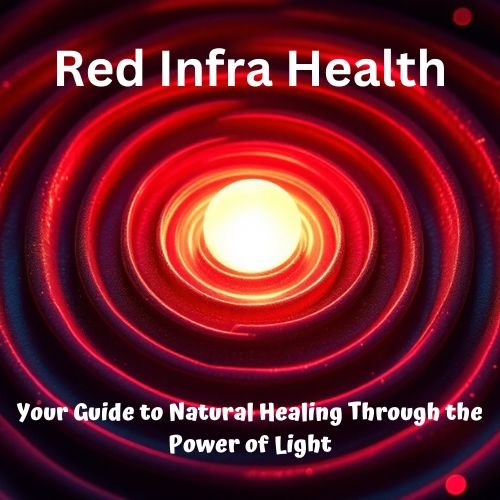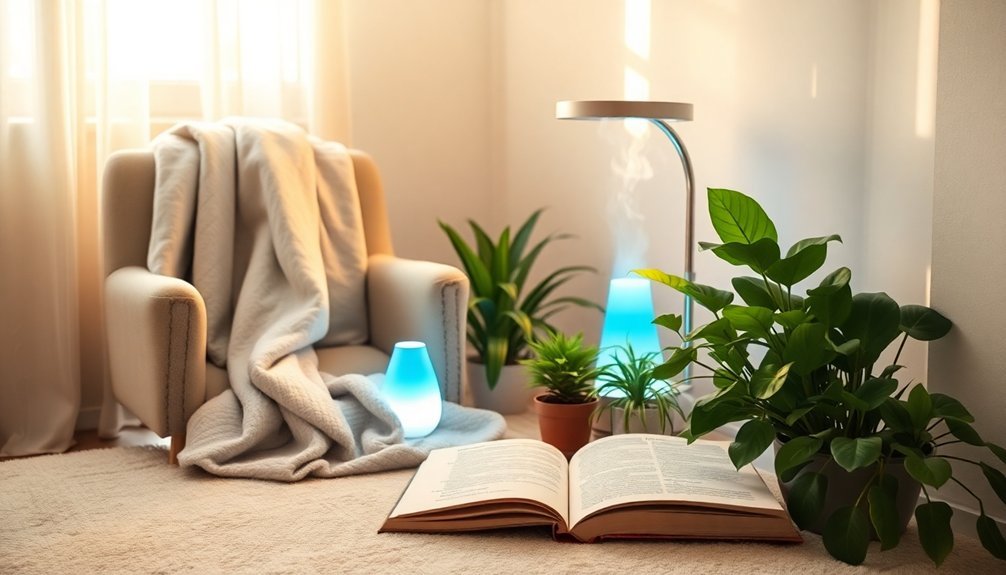To naturally radiate away your depression, start by incorporating light therapy into your routine. This approach simulates sunlight, boosting your mood and serotonin levels. Pairing this with nutrient-dense foods, like omega-3s and colorful fruits, can elevate your mental health. Regular physical activity also releases endorphins, while mindfulness techniques help manage negative thoughts. Engaging in creative outlets like journaling or art fosters emotional release. Don't forget to nurture your social connections, as strong ties can greatly improve your well-being. Discover more effective methods to enhance your mood and embrace a brighter outlook on life.
Understanding Light Therapy

When you consider options for managing depression, light therapy stands out as a powerful tool. This approach involves exposing yourself to an artificial light source, like a lightbox or lamp, which can help regulate your biological clock, or circadian rhythm. By aligning your brain's 24-hour cycle, light therapy boosts serotonin activation, an essential factor in mood regulation.
There are several types and methods of light therapy to explore. Bright light therapy typically uses lightboxes that simulate natural outdoor light, while dawn simulation replicates the gradual increase in morning light, aiding your wake-up routine. Blue light therapy is another option, focusing on blue light exposure believed to enhance serotonin production. Consistent use of light therapy may help reset circadian rhythms, facilitating a smoother transition into your daily routine.
The light therapy boxes generally output between 2,500 and 10,000 lux, with adjustable session times to fit your individual needs—usually around 30 minutes daily.
As you investigate light therapy, keep in mind its effectiveness in treating major depressive disorder, whether seasonal or non-seasonal. Many experience symptom improvement in just a few days to weeks. This method offers a promising, relatively safe alternative or complement to traditional treatments.
Benefits of Red Light Therapy
Red light therapy offers a promising approach to alleviating depression by directly targeting mood stabilization and enhancing overall mental well-being. By boosting dopamine and serotonin levels, this therapy can enhance your feelings of pleasure and focus. Improved blood flow to the brain promotes new cell development and helps reduce inflammation, fostering a healthier mental state. Additionally, it has been established as a treatment of choice for seasonal affective disorder and shows preliminary evidence for effectiveness in chronic depression.
Here's a quick overview of its benefits:
| Key Benefits | Description |
|---|---|
| Direct Depression Relief | Reduces symptoms while enhancing mood stability. |
| Enhances Mental Clarity | Increases confidence and supports better emotional regulation. |
| Effective for Specific Conditions | Helps treat Seasonal Affective Disorder, major depressive disorder, and anxiety. |
| Practical and Safe | Easy to use with no serious side effects, often showing results after just a few sessions. |
Incorporating red light therapy into your routine doesn't just provide immediate mood benefits; it also works to reduce stress and anxiety, offering a brighter outlook on life. Plus, it's a non-invasive option that complements other treatments, making it a versatile addition to your mental health strategy.
How Infrared Light Works

Moving from red light therapy, let's explore how infrared light works to support mental well-being. Infrared light stimulates your brain cells, encouraging energy production essential for normal brain activities. Key players in this process are cytochrome c oxidase in mitochondria and calcium ion channels. When infrared photons are absorbed, they kickstart increases in ATP, create a short burst of reactive oxygen species, and elevate nitric oxide levels.
One of the standout features of infrared light is its ability to penetrate deep into your body, reaching up to 1.5 inches beneath your skin. This deep penetration allows it to target tissues like muscles and joints effectively, making it a potent tool for various therapeutic applications. Infrared light can cause local vasodilation, enhancing blood flow and nutrient delivery. Additionally, far infrared rays can deeply penetrate body tissues, promoting even greater therapeutic effects.
Furthermore, this therapy can reduce oxidative stress and bolster antioxidant defenses, further supporting overall brain health. With its capacity to modulate calcium levels and activate transcription factors, infrared light promotes cell survival and repair.
Mood Enhancement Through Light
Getting enough sunlight can greatly boost your mood and energy levels, making those sunny days something to look forward to.
If you're not getting enough natural light, light therapy options, like using a lightbox, can provide the same benefits.
Let's explore how both sunlight exposure and artificial light can brighten your day.
Sunlight Exposure Benefits
Exposure to sunlight offers many benefits for mood enhancement, greatly impacting your emotional wellbeing. When you soak up those rays, your body ramps up serotonin production, a neurotransmitter linked to happiness and mood regulation.
This natural light exposure triggers your brain to release serotonin, boosting both mood and energy levels—essential, especially if you're struggling with Seasonal Affective Disorder (SAD).
Consider these sunlight exposure benefits:
- Increases serotonin, elevating your mood and emotional stability.
- Promotes relaxation and decreases stress, making daily challenges more manageable.
- Enhances sleep quality by regulating melatonin production, so you wake up refreshed.
- Encourages outdoor activities, benefiting overall physical and mental health.
Light Therapy Options
For those who can't get enough natural sunlight or live in areas with long winters, light therapy offers a practical solution to boost your mood. This treatment works by aligning your biological clock and balancing serotonin levels, enhancing your overall mood and energy. Typical light therapy involves using a lightbox with a brightness of 2,500 to 10,000 lux during morning sessions, generally lasting 30 minutes.
Here's a brief overview of light therapy options:
| Aspect | Details |
|---|---|
| Best Time to Use | Morning, 6:00 a.m. – 9:00 a.m. |
| Duration of Sessions | Start with 30 minutes, adjust as needed |
| Expected Improvement | Symptoms may improve within a week |
Light therapy can be just as effective as medications or psychotherapy and typically causes fewer side effects. It's safe with minimal risks, often only leading to mild issues like eye strain if used improperly. Remember to avoid using the lightbox near bedtime to guarantee consistent sleep. If you're looking for a natural mood booster, light therapy might be the bright solution you need!
Combining Light Therapy With Supplements

The synergy between light therapy and dietary supplements can enhance your mental health journey, especially when battling depression.
Combining these two approaches may offer greater relief than using either method alone. For example, light therapy is known to improve serotonin activation, a vital factor in mood regulation.
When you supplement with nutrients that support brain health, like omega-3 fatty acids or vitamin D, you're providing your body with additional tools to fight depression.
Consider incorporating these supplements into your routine:
- Omega-3 Fatty Acids: Support brain function and reduce depressive symptoms.
- Vitamin D: Essential for mood regulation and can mitigate feelings of sadness.
- B Vitamins: Important for energy production and neurological function.
- Magnesium: Helps to alleviate anxiety and supports overall brain health.
Foods to Boost Your Mood
Incorporating the right foods into your diet can greatly enhance your mental well-being, especially when paired with light therapy and supplements. A nutrient-packed diet is vital for lifting your mood. Focus on foods rich in omega-3 fatty acids, like salmon, mackerel, and walnuts, which can improve mood and combat inflammation. Consuming these can be particularly beneficial if you experience depressive symptoms.
Don't overlook high-fiber and whole grain foods, such as oatmeal and sweet potatoes. These help release serotonin, stabilizing blood sugar levels and preventing mood swings. They also nourish your gut microbiome, which is closely linked to mental health.
Integrating foods with amino acids and B vitamins is important too. Eggs, poultry, and low-fat dairy products can enhance serotonin production. Bananas are great for modulating mood and sleep.
Finally, include polyphenol-rich foods like dark chocolate, berries, and antioxidant-laden vegetables. They've been shown to improve depressive symptoms and contribute to overall mental health.
With these dietary changes, you can elevate your mood naturally and effectively.
The Role of Exercise in Healing

Exercise plays an essential role in healing your mind and body from depression.
By engaging in regular workouts, you'll not only boost your mood through the release of endorphins but also improve your overall mental health.
Whether it's aerobic activities, strength training, or yoga, finding the right type of exercise can make a significant difference.
Benefits of Regular Exercise
Regular physical activity offers a powerful boost in your journey toward alleviating depression. Engaging in regular exercise brings a host of biological and psychological benefits that can transform how you feel. It's not just about breaking a sweat; it's about fostering a healthier mind and spirit.
- Supports nerve cell growth in the hippocampus, improving mood and cognitive functions.
- Releases endorphins, giving you that famous "runner's high" and reducing feelings of anxiety.
- Acts as a natural treatment for mild to moderate depression, often without side effects.
- Enhances self-confidence and serves as a distraction from negative thoughts.
Incorporating exercise into your routine can lower muscle tension, improve sleep, and regulate hormonal balance.
By focusing on achievable goals and scheduling workouts when you're most energized, you create a sustainable habit that promotes well-being.
You'll notice sharper concentration and greater emotional resilience, making it easier to manage symptoms of anxiety and depression.
Embrace regular exercise as not just a physical necessity, but a pathway to a brighter, more balanced life. Your journey to emotional healing starts with that first step!
Types of Effective Workouts
Finding the right type of workout is key to maximizing the benefits of your exercise routine. Aerobic exercises like walking, jogging, running, cycling, and swimming are excellent for reducing depressive symptoms.
Even a brisk walk can uplift your mood and lessen stress if high-intensity workouts don't suit you. Aim for at least 30 minutes of moderate-intensity aerobic activity on most days to see improvement.
Don't overlook strength training; it's just as effective as aerobic workouts for combating depression. By incorporating exercises like push-ups and squats, you can enhance your muscle strength and boost your self-esteem.
Aim for two to three strength sessions weekly.
Yoga, alongside other mind-body exercises, has shown remarkable results in reducing depressive symptoms. Its focus on mindfulness helps keep you grounded and can be both calming and restorative.
Complementing your routine with tai chi or qigong can also contribute positively to your mental health.
Mindfulness Techniques for Depression
When you're grappling with depression, incorporating mindfulness techniques can greatly help in managing rumination and negative thoughts.
Practicing mindfulness allows you to redirect your focus to the present moment, reducing stress and promoting relaxation. Here are a few techniques you can start with:
- Mindful Breathing: Focus on your breath, allowing it to ground you and release negativity. Deep, belly breathing activates your body's relaxation response.
- Body Scan Meditation: Mentally scan your body from head to toe, noticing sensations and easing tension. This technique cultivates awareness and helps you relax.
- Five Senses Meditation: Engage with your environment by identifying what you see, hear, feel, smell, and taste. This practice helps you stay rooted in the now.
- Mindful Walking: Pay attention to each step and the sensations of walking. This not only enhances awareness but also connects you to your surroundings.
Nature's Impact on Mental Health

Mindfulness techniques help you manage the mind's tendency to dwell on the negative, but there's another powerful ally in improving your mental health: nature. Just five minutes in a natural setting can greatly reduce stress, helping regulate your sympathetic nervous system and steady your heart rate. This exposure lowers cortisol levels, which means less physiological stress.
Nature isn't just about feel-good moments; it serves as an effective coping strategy for chronic conditions like depression, anxiety, and PTSD. Research shows that spending time in green environments enhances your attention, creativity, and memory, smoothing out the cognitive bumps that often accompany mental health struggles.
You'll find that connecting with nature lifts your mood, combats feelings of loneliness, and promotes positive interactions with others. Whether it's a walk in the park or noticing a simple tree on your street, those everyday connections matter.
Engaging with diverse natural elements—like the sounds of birds or the scent of flowers—can enhance your mental restoration and calm. Embrace these opportunities, and watch as your overall sense of well-being flourishes in the embrace of nature.
Creative Outlets for Emotional Release
Finding creative outlets can be a powerful way to release emotions and enhance your well-being.
Whether you're journaling to reflect on your thoughts, creating art to express what's hard to say, or using music to soothe your soul, each activity offers unique benefits for mental health.
Embracing these activities can help you process feelings and find a sense of peace.
Journaling for Self-Reflection
How can journaling transform the way you understand your emotions? By putting pen to paper, you create a safe space to explore your deepest thoughts and feelings. This practice helps you identify patterns and triggers that influence your well-being, allowing for enhanced self-awareness and emotional regulation.
Here are some benefits of journaling for self-reflection:
- It provides a therapeutic release valve for pent-up emotions.
- You can articulate and challenge negative thought patterns.
- It cultivates self-compassion and personal growth.
- You'll gain clearer insights into your emotional landscape.
As you routinely engage in journaling, you'll find it reduces stress, anxiety, and depressive symptoms. It may even rival cognitive-behavioral therapy's effectiveness in lowering depression risk.
By incorporating journaling into your daily self-care routine, you foster a deeper connection with your inner self while promoting mindfulness.
Start with simple prompts before diving deeper into more complex issues. With each entry, you enhance your mental clarity and cultivate a sense of calm, transforming your understanding of your feelings and experiences.
Music as Emotional Therapy
Engaging in music as an emotional therapy can greatly enhance your journey of self-discovery initiated through journaling. Music has a unique ability to evoke deep emotions, from joy to sadness, allowing you to release pent-up feelings that may be hard to articulate.
Whether you're listening or playing an instrument, music encourages physical movement, which can help enhance your overall well-being, even if you face mobility challenges.
Active participation in music can considerably reduce stress and anxiety. You might find that your emotional state improves after a session, as music therapy stimulates key brain areas linked to emotional regulation. It offers a creative outlet to express your feelings while creating a sense of connection with others, reducing feelings of isolation.
Additionally, you'll notice that achieving new skills in music can boost your confidence and self-esteem. Successfully creating or experiencing music fosters a sense of accomplishment that translates into emotional control.
When you engage with music that you enjoy, your brain's reward circuits activate, releasing feel-good hormones like dopamine. In this way, music becomes not just a form of therapy but a powerful tool for emotional healing and growth.
Engaging in Arts and Crafts
Artistic expression serves as a powerful outlet for emotional release, enabling you to channel your feelings through creativity. Engaging in arts and crafts can greatly improve your mental well-being. By allowing yourself to create, you can gain insight into your emotions while providing relief from stress and anxiety.
Consider these therapeutic benefits as you explore different forms of artistic activities:
- Improves self-awareness: Art helps you better understand your emotions, thoughts, and behaviors.
- Provides emotional catharsis: Creating art allows you to express and release pent-up feelings.
- Enhances communication: Art can articulate feelings that are hard to convey with words.
- Boosts self-esteem: Completing art projects instills a sense of achievement and confidence.
Whether you're painting your emotions, crafting gratitude collages, or even working with clay, engaging in these activities fosters a sense of accomplishment and can distract you from negative thoughts.
As you immerse yourself in creativity, you may find peace and clarity, paving the way for hope and future planning. So go ahead—pick up a brush, clay, or fabric, and let your emotions flow through your art.
Social Connections and Their Benefits

Building strong social connections can be a powerful antidote to depression. When you have a robust network of friends and family, you're less likely to feel isolated and alone. These connections not only offer emotional support but also create a sense of belonging that can greatly lower your risk of experiencing depressive symptoms.
In fact, individuals with strong social ties have a 63% lower risk of depression.
Having friends to lean on enhances your resilience during tough times, enabling you to cope with stress more effectively. Positive interactions with others help release endorphins, boosting your mood and reducing anxiety.
You'll also find that those with deeper social bonds enjoy better mental health outcomes, including improved sleep quality and a stronger immune system.
Furthermore, nurturing these relationships can actually increase your longevity and enhance your quality of life. Engaging socially stimulates your brain, keeping cognitive decline at bay.
Creating a Personalized Routine
Establishing a personalized routine can be a transformative step towards managing depression effectively. Begin by evaluating your current situation and identifying areas where you feel lacking or bored. By setting clear, achievable goals, you'll create a sense of direction. Analyze your habits to see what works and what doesn't, considering both short-term and long-term objectives.
To enhance your routine, incorporate meaningful activities that spark joy and promote personal growth, such as:
- Engaging in physical activities like yoga or dancing to boost your endorphins.
- Volunteering to foster a sense of purpose and connection.
- Learning new skills or pursuing hobbies that excite you.
- Practicing relaxation techniques like meditation or journaling to center your thoughts.
Balance structure with flexibility by creating a daily framework that allows room for spontaneity. Prioritize self-care, ensuring you get enough sleep, regular exercise, and proper nutrition.
As you implement your routine, be open to adjustments; it should serve you, not constrain you. By taking these steps, you'll gradually cultivate a more fulfilling daily life that helps radiate your depression away.
Frequently Asked Questions
Can Light Therapy Replace Traditional Antidepressant Medications?
Light therapy can effectively complement or even replace traditional antidepressant medications for many individuals. With fewer side effects and quicker results, it's worth exploring light therapy as a viable treatment option to enhance your mood.
How Long Does It Take to See Results From Light Therapy?
You'll likely notice initial improvements within a few days of starting light therapy. For more significant effects, especially from morning sessions, expect to see changes after about three weeks, depending on your individual response.
Are There Any Side Effects of Using Light Therapy?
Yes, light therapy can cause side effects like headaches, nausea, and jumpiness. These are generally mild and temporary. You should monitor how you feel and consult your doctor if they persist or worsen.
What Time of Day Is Best for Light Therapy Sessions?
The best time for light therapy sessions is in the morning. You should aim for 20 to 30 minutes of exposure to bright light, which helps improve mood and regulate your circadian rhythm effectively.
Can Light Therapy Be Used for Seasonal Affective Disorder (Sad)?
Yes, you can use light therapy for seasonal affective disorder (SAD). It's shown to be effective in reducing depression symptoms, comparable to cognitive behavioral therapy and antidepressants, enhancing your mood during those darker months.
In Summary
Embracing natural methods to brighten your mood can truly transform your experience with depression. By incorporating light therapy, connecting with nature, and engaging in creative activities, you can foster a positive outlook on life. Don't overlook the warmth of social connections, either—they're essential for your mental well-being. Remember, creating a personalized routine that combines these elements can lead to lasting change. Start today, and take the first step toward radiant mental health. You've got this!





Leave a Reply